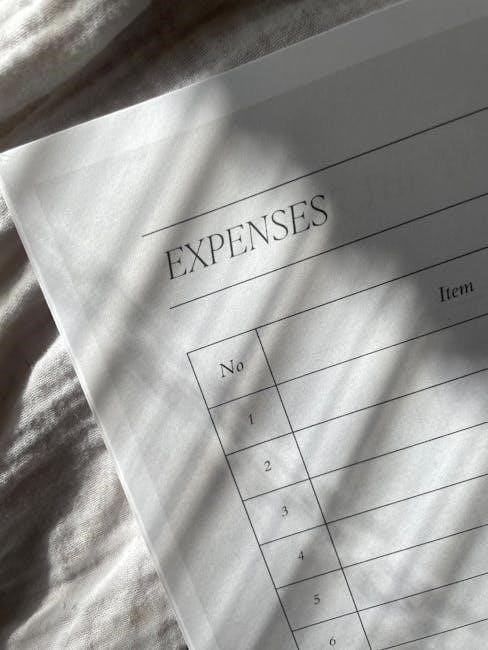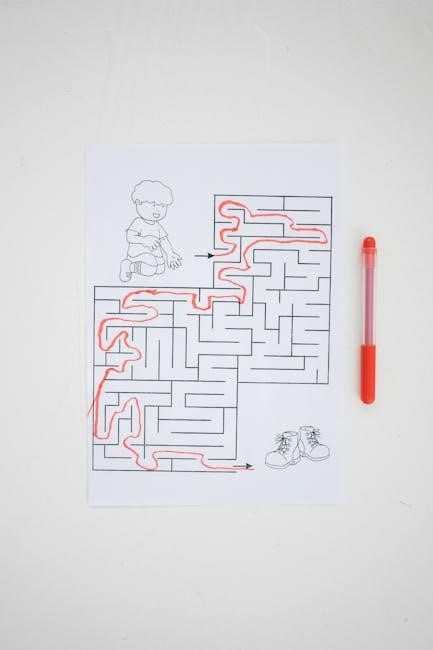Inequalities worksheets with answers provide a comprehensive resource for learning and practicing inequality concepts. These PDF worksheets include various practice problems, solutions, and graphing exercises. They offer a structured approach to understanding inequalities, allowing students to self-assess and improve their skills. The free downloadable format ensures accessibility, while detailed answers enable immediate feedback and progress tracking. Perfect for classroom or home study, these worksheets cover basic to advanced topics, making them ideal for learners of all levels.
1.1 What Are Inequalities Worksheets?
Inequalities worksheets are educational resources designed to help students practice and master the concept of solving inequalities. These worksheets typically include a variety of problems, such as solving linear, quadratic, and rational inequalities, as well as graphing solutions on a number line. They often come with answers, allowing students to check their work and receive immediate feedback. Available in PDF format, these worksheets are easy to download, print, and use for homework or self-study. They cater to different skill levels, ensuring a structured learning experience.
1.2 Importance of Using Worksheets with Answers
Using worksheets with answers is essential for effective learning and self-assessment. These resources provide immediate feedback, allowing students to identify and correct mistakes. The inclusion of answers enables learners to track their progress and understand their strengths and weaknesses. Worksheets with answers also reinforce learning by offering clear solutions, which can be reviewed repeatedly. This structured approach helps build confidence and ensures a thorough understanding of inequality concepts, making them a valuable tool for both students and educators.
1.3 Benefits of PDF Format for Worksheets
The PDF format offers numerous advantages for worksheets, ensuring universal compatibility across devices. PDFs maintain consistent formatting and clarity, making them ideal for printing; They are easily accessible and can be downloaded for offline use, providing flexibility for learners. PDF worksheets are also environmentally friendly, reducing the need for paper. Additionally, they often include interactive features, such as fillable fields, enhancing the learning experience. Overall, the PDF format is a practical and efficient choice for sharing and utilizing inequalities worksheets with answers.

Understanding Inequalities
Inequalities are statements comparing values using symbols like <, >, or ≠. They help solve real-world problems, such as budgeting, and are fundamental in algebraic problem-solving.
2.1 Basic Concepts of Inequalities
Inequalities are mathematical statements comparing values using symbols like <, >, ≤, ≥, and ≠. They express relationships between numbers, variables, or expressions. Understanding inequalities begins with recognizing these symbols and their meanings. For example, x > 5 means x is greater than 5, while 3 ≤ y means y is at least 3. These concepts form the foundation for solving and graphing inequalities, essential skills in algebra and real-world applications. Mastering basic inequalities is crucial for progressing in mathematics.
2.2 Types of Inequalities: Linear, Quadratic, and Rational
Inequalities are categorized into types based on their structure and complexity. Linear inequalities involve variables to the first degree, like 2x + 3 > 5. Quadratic inequalities, such as x² ー 4x ⎻ 5 < 0, include squared terms. Rational inequalities contain fractions with variables in the denominator, e.g., (x ⎻ 1)/(x + 2) > 0. Each type requires specific solving techniques, making it essential to identify and understand them for accurate solutions in algebra and higher-level math problems.
2.3 Why Inequalities Are Important in Mathematics
Inequalities are fundamental in mathematics as they enable comparisons and define ranges of values. They are essential for solving real-world problems, such as budgeting, resource allocation, and optimization. Inequalities help model scenarios where exact values are not required, providing flexibility in solutions. They are crucial in advanced math, including algebra, calculus, and data analysis. Understanding inequalities enhances critical thinking and problem-solving skills, making them a cornerstone of mathematical literacy and practical application in various fields.

Solving Linear Inequalities
Solving linear inequalities involves isolating the variable using inverse operations. Unlike equations, inequalities require reversing the sign when multiplying or dividing by negatives. Practice worksheets help master these steps.
3.1 One-Step Inequalities
One-step inequalities are the simplest form of inequalities, requiring only one operation to isolate the variable. Examples include x + 5 > 10 or x / 3 < 4. To solve these, apply the inverse operation to both sides. For instance, subtract 5 from both sides in the first example to find x > 5. If multiplying or dividing by a negative, remember to reverse the inequality sign. These problems are foundational for more complex inequalities and help build essential algebra skills. Regular practice with one-step inequalities ensures mastery of basic inequality principles.
3.2 Two-Step Inequalities
Two-step inequalities involve solving for a variable in two or more operations. These inequalities require applying multiple inverse operations, such as addition/subtraction followed by multiplication/division. For example, solving 2x + 4 > 10 involves subtracting 4 and then dividing by 2 to find x > 3. When multiplying or dividing by a negative number, remember to reverse the inequality sign. Regular practice with two-step inequalities helps build confidence and prepares students for more complex algebraic problems. Worksheets with detailed answers provide excellent practice opportunities.
3.3 Solving Inequalities with Multiplication and Division
Solving inequalities involving multiplication or division requires careful attention to the inequality sign. When multiplying or dividing both sides by a positive number, the inequality direction remains unchanged. However, if multiplying or dividing by a negative number, the inequality sign must be reversed. For example, solving -3x > 6 involves dividing both sides by -3 and reversing the inequality, resulting in x < -2. Practice worksheets with answers help reinforce this critical rule and improve problem-solving skills.
3.4 Solving Inequalities with Addition and Subtraction
Solving inequalities with addition or subtraction follows similar rules to equations. To isolate the variable, add or subtract the same number to/from both sides. For example, in x + 5 < 10, subtracting 5 from both sides gives x < 5. Similarly, in y ー 3 > 7, adding 3 to both sides results in y > 10. These operations maintain the inequality direction, ensuring accurate solutions. Worksheets with answers provide ample practice for mastering these essential skills and understanding the impact of operations on inequality outcomes.

Graphing Inequalities on a Number Line
Graphing inequalities on a number line provides a visual representation of solutions. Use closed circles for inclusive values and arrows for continuous ranges. This method helps students understand inequality relationships intuitively.
4.1 How to Represent Inequality Solutions Visually
Visually representing inequality solutions involves using a number line. For example, x > 3 is shown with an open circle at 3 and an arrow extending right. Use closed circles for inclusive values like x ≤ 5. Compound inequalities, such as 2 ≤ x < 4, are depicted with closed circles at both endpoints and a line between them. This clear, concise method helps students grasp inequality concepts quickly and effectively, making problem-solving more engaging and understandable.
4.2 Tips for Accurate Graphing
Accurate graphing of inequalities requires attention to detail. Always identify the inequality type first, such as linear or compound. Use open circles for strict inequalities and closed circles for inclusive ones. For compound inequalities, connect the circles with a line. Double-check endpoints and directions, especially when reversing signs during division or multiplication by negatives. Regular practice and reviewing examples ensure mastery. These tips help students avoid common mistakes and enhance their understanding of inequality solutions on a number line.
Types of Inequalities Worksheets
Inequalities worksheets include simple, compound, and absolute value problems. They cover one-step, two-step, and graphing inequalities, offering structured practice for understanding and solving various inequality types effectively.
5.1 Simple Inequalities
Simple inequalities involve basic expressions with a single inequality symbol, such as less than (<) or greater than (>). These problems typically require one-step operations like addition, subtraction, multiplication, or division. For example, solving ( x > 5 ) or ( y < -3 ). Worksheets often include exercises where students isolate the variable by performing the same operation on both sides. Graphing solutions on a number line reinforces understanding, visually showing the range of values that satisfy the inequality. This foundational practice builds essential algebraic manipulation skills, crucial for tackling more complex inequality types. Regular practice with simple inequalities ensures a strong grasp of inequality properties and prepares students for advanced problem-solving in mathematics. By focusing on straightforward scenarios, these exercises help learners develop confidence and fluency in inequality concepts.
5.2 Compound Inequalities
Compound inequalities involve two inequality statements combined, often with “and” or “or.” For example, ( x > 3 ) and ( x < 7 ) represents values of x between 3 and 7. These inequalities require solving each part separately and understanding the combined solution set. Worksheets include exercises like graphing on a number line and solving compound statements. This helps learners visualize the overlap or union of solutions, reinforcing the logic behind "and" and "or" conditions. Regular practice with compound inequalities strengthens algebraic reasoning and prepares students for more complex mathematical expressions. These exercises are essential for mastering inequality relationships and their real-world applications. By focusing on compound scenarios, students refine their ability to interpret and solve multi-part inequality problems effectively.
5.3 Absolute Value Inequalities
Absolute value inequalities involve expressions like |x| < 5 or |x| > 3. They represent distances on the number line, requiring solutions within or outside a specific range. Worksheets provide exercises to solve and graph these inequalities, such as |2x + 1| ≤ 7 or |3x ー 4| > 2. Students learn to break them into compound inequalities, like -5 < x < 5 or x < -3 or x > 3. Graphing helps visualize the solution sets, enhancing understanding of absolute value properties and their practical applications in real-world problems.

Key Concepts in Solving Inequalities
Mastering inequalities requires understanding direction reversal when multiplying/dividing by negatives and maintaining direction with positives. The number line aids in visualizing solutions, ensuring accurate representations of inequality ranges.
6.1 Reversing the Inequality Sign
Reversing the inequality sign is crucial when multiplying or dividing both sides by a negative number. This rule ensures the inequality’s direction remains accurate. For example, if you have ( 5 > 3 ) and multiply both sides by -1, it becomes ( -5 < 3 ). Forgetting to reverse the sign is a common mistake, leading to incorrect solutions. Always underline or highlight the inequality when reversing to avoid errors. This concept is fundamental for solving inequalities accurately and consistently. Proper attention ensures reliable results in all inequality problems.
6.2 Understanding the Number Line
The number line is a visual tool essential for understanding inequalities. It displays numbers in order, with values increasing to the right and decreasing to the left. When solving inequalities, graphing solutions on a number line helps visualize the range of values. For example, x > 3 is represented by shading numbers greater than 3. Key points include plotting endpoints as open or closed circles and recognizing intervals. This method aids in comparing numbers and solving inequalities accurately, reinforcing mathematical concepts effectively.
6.3 Solving Inequalities with Variables on Both Sides
Solving inequalities with variables on both sides requires strategic manipulation to isolate the variable. Start by moving all variable terms to one side and constants to the other using addition, subtraction, multiplication, or division. For example, given 3x + 2 > 5x ー 4, subtract 5x from both sides to get -2x + 2 > -4. Next, isolate the variable by subtracting 2 from both sides, yielding -2x > -6. Finally, divide by -2, remembering to flip the inequality sign, resulting in x < 3. This method ensures clarity and accuracy in finding the solution range.
Practice Resources
Access free PDF worksheets and printable resources to practice solving inequalities. These materials include detailed problems, solutions, and graphing exercises for self-assessment and feedback, ensuring comprehensive learning.
7.1 Free PDF Worksheets for Inequalities
Free PDF worksheets for inequalities are a valuable resource for mastering inequality concepts. These downloadable sheets include various problem types, such as linear, quadratic, and rational inequalities, along with detailed solutions. They allow students to practice solving inequalities step-by-step and graph solutions on a number line. The PDF format ensures easy printing and access, making them ideal for both classroom and home study. Regular practice with these worksheets helps build problem-solving skills and confidence in handling inequalities effectively.
7.2 Printable Worksheets with Answers
Printable worksheets with answers are an excellent tool for learning inequalities. Each worksheet includes a variety of problems, such as one-step, two-step, and compound inequalities, along with detailed solutions. Students can practice solving inequalities and check their work immediately. The included answers provide clear feedback, helping to identify areas for improvement. These worksheets are ideal for independent study or classroom use, offering a structured way to master inequality concepts and apply them to real-world problems effectively. Regular use enhances problem-solving skills and mathematical understanding.

Benefits of Using Worksheets with Answers
Worksheets with answers offer immediate feedback, helping students track progress and reinforce learning. They provide clarity, build confidence, and ensure mastery of inequality concepts through structured practice.
8.1 Immediate Feedback
Worksheets with answers provide immediate feedback, allowing students to verify their solutions instantly. This feature helps identify mistakes early, promoting self-correction and deeper understanding. By comparing their work with the provided answers, learners can assess their grasp of inequality concepts and address gaps in knowledge. This instant verification fosters a more efficient learning process and enhances overall performance in solving inequalities. It also reduces reliance on instructors for every check, encouraging independent study and accountability.
8.2 Tracking Progress
Worksheets with answers enable students to track their progress effectively. By completing exercises and comparing their solutions with the provided answers, learners can monitor their improvement over time. This feature allows them to identify strengths and areas needing further practice. Regularly reviewing their work helps build confidence and reinforces understanding of inequality concepts. The ability to see growth motivates students to stay engaged and strive for mastery of the material. This tool supports a structured and goal-oriented approach to learning inequalities.
8.3 Reinforcing Learning
Worksheets with answers reinforce learning by providing structured practice and immediate feedback. Students can revisit challenging problems, solidifying their understanding of inequalities. The PDF format ensuresAccessibility, allowing learners to practice anytime. Regular use of these resources builds confidence and mastery, as repetitive practice strengthens problem-solving skills. The ability to self-assess and correct mistakes fosters a deeper grasp of inequality concepts, making these worksheets an invaluable tool for long-term retention and academic success in mathematics.

How to Use Inequalities Worksheets Effectively
To use inequalities worksheets effectively, start with simple problems and progress to more complex ones. Regular practice helps build skills and confidence. Use the provided answers for immediate feedback and to identify areas needing review. Focus on understanding key concepts like reversing inequality signs when multiplying or dividing by negatives. Consistent practice and reviewing mistakes will enhance your ability to solve inequalities accurately.
9.1 Step-by-Step Practice
Step-by-step practice is essential for mastering inequalities. Begin with one-step inequalities, ensuring understanding of basic operations. Progress to two-step problems, incorporating both addition/subtraction and multiplication/division. Pay special attention to reversing the inequality sign when multiplying or dividing by negatives. Use worksheets to systematically work through each problem, referencing provided answers for immediate feedback. This methodical approach helps solidify concepts and builds confidence in solving more complex inequalities. Regular review of mistakes further reinforces learning and improves problem-solving skills over time.
9.2 Regular Review and Practice
Consistent review and practice are crucial for retaining inequality skills. Regularly revisit problems to reinforce understanding and identify areas needing improvement. Use PDF worksheets to practice various inequality types, ensuring familiarity with different problem structures. Over time, this routine builds proficiency and reduces errors. Incorporate answer keys to verify solutions and learn from mistakes. Sustained effort enhances problem-solving speed and accuracy, making complex inequalities more manageable. Dedicate time daily to maintain and advance your skills in inequalities.

Common Mistakes in Solving Inequalities
Consistent review and practice are essential for mastering inequalities. Regularly revisiting problems helps reinforce concepts and identify areas for improvement. Utilize PDF worksheets to engage with various inequality types, ensuring familiarity with different problem structures. Incorporate answer keys to verify solutions and learn from mistakes. Over time, this routine enhances problem-solving speed and accuracy. Dedicate time daily to maintain and advance your skills in inequalities, ensuring long-term proficiency and confidence.
10.1 Forgetting to Reverse the Inequality Sign
One of the most common errors when solving inequalities is neglecting to reverse the inequality sign. This mistake often occurs when multiplying or dividing both sides by a negative number. For example, if you have an inequality like -5x < 10, dividing both sides by -5 requires reversing the sign, resulting in x > -2. Forgetting this rule leads to incorrect solutions. Practicing with worksheets that include answers can help identify and correct this mistake, ensuring proper understanding of inequality rules.
10.2 Misapplying Operations
Misapplying operations is a frequent error when solving inequalities. This often occurs when students incorrectly handle negative numbers or fail to maintain balance in the inequality. For instance, adding or subtracting inconsistently across sides can lead to incorrect solutions. Additionally, misapplying multiplication or division, especially with negatives, is a common pitfall. Worksheets with answers help identify such mistakes, emphasizing the importance of careful step-by-step execution to avoid these errors and ensure accurate inequality solutions.
Real-World Applications of Inequalities
Inequalities are essential in real-world scenarios like budgeting, where they help set financial limits, and distance-speed problems, enabling calculations of minimum or maximum values for efficient planning and decision-making.
11.1 Budgeting and Finance
Budgeting and finance heavily rely on inequalities to manage and allocate funds effectively. For instance, setting a maximum expenditure limit for a project or determining the minimum savings required for a goal. Inequalities help in creating financial models that account for variables like income, expenses, and investments. They enable individuals and businesses to make informed decisions, ensuring resources are utilized optimally while avoiding deficits. This practical application highlights how inequalities are indispensable in maintaining financial stability and planning for the future.
11.2 Distance and Speed Problems
Distance and speed problems often involve inequalities to determine feasible solutions. For example, calculating the maximum distance a vehicle can travel on a given amount of fuel or ensuring a delivery arrives within a specific time frame. Inequalities help in setting constraints, such as minimum speed requirements or maximum allowable distances, ensuring efficient route planning and timely arrivals. These applications demonstrate how inequalities are essential for solving real-world problems involving motion and constraint-based scenarios.

Finding the Right Worksheet
Selecting the appropriate worksheet involves considering the student’s skill level and the specific inequality concepts being studied. Ensure the worksheet includes detailed answers for self-assessment and covers relevant topics like linear, quadratic, or compound inequalities. Choosing the right difficulty level helps reinforce learning and builds confidence in solving inequalities effectively.
12.1 Choosing the Appropriate Difficulty Level
Selecting the right difficulty level for inequalities worksheets ensures effective learning. For beginners, start with simple one-step inequalities and gradually progress to multi-step problems. Advanced learners can tackle compound or absolute value inequalities. The free PDF worksheets available online cater to various skill levels, allowing teachers and students to choose resources that match their current understanding. This tailored approach helps build a strong foundation and prevents overwhelming learners with complex problems too early.
12.2 Selecting Worksheets with Detailed Answers
Worksheets with detailed answers are essential for self-assessment and understanding. They provide step-by-step solutions, helping learners grasp concepts and identify mistakes. Free PDF resources, such as those from Kuta Software and MathWorksheets4Kids, offer comprehensive answer keys. These tools enable students to verify their work and understand problem-solving strategies. Detailed answers also clarify complex steps for solving inequalities, ensuring a deeper understanding of the material. They are particularly useful for independent study and homework review, making learning more efficient and effective. Always opt for worksheets with clear, detailed solutions for better learning outcomes.
FAQs address common queries about inequalities, such as the difference between equations and inequalities, and when to reverse inequality signs. These questions provide clarity and guidance, helping learners understand key concepts and avoid mistakes. They are essential for resolving confusion and improving problem-solving skills. FAQs are often included in worksheets to enhance learning and ensure a solid grasp of inequality principles. They offer quick solutions to common issues faced by students. An equation states that two expressions are equal, using an equals sign (=), while an inequality compares two expressions, using symbols like <, >, ≤, or ≥. Equations have specific solutions, whereas inequalities involve a range of values. For example, x = 5 is an equation, but x < 5 is an inequality. Understanding this distinction is crucial for solving and graphing problems accurately. Inequalities often require additional steps, such as reversing the sign when multiplying or dividing by negatives, which does not apply to equations. This fundamental difference impacts how solutions are interpreted and visualized. You reverse the inequality sign when multiplying or dividing both sides by a negative number. This rule applies because negatives change the order of numbers on the number line. For example, if you have 5 > 3 and multiply both sides by -1, it becomes -5 < -3. Always remember to reverse the sign when dealing with negative coefficients or during division by negatives. This critical step ensures inequalities remain balanced and solutions are accurate. Practice consistently to master this essential skill. The conclusion emphasizes the effectiveness of inequalities worksheets with answers in PDF format for mastering inequality concepts. These resources provide comprehensive practice, immediate feedback, and skill improvement, ensuring a strong foundation in inequalities. Regular practice with these worksheets is highly encouraged for continued progress and mastery. Inequalities worksheets with answers in PDF format are essential tools for learning and mastering inequality concepts. They cover various types, such as linear, quadratic, and rational inequalities, and include exercises on solving and graphing. The worksheets provide immediate feedback through detailed answers, helping students track progress and reinforce learning. Regular practice with these resources is crucial for building problem-solving skills and understanding real-world applications. They are ideal for both classroom and home study, catering to learners of all levels. Utilizing these worksheets ensures a strong foundation in inequalities, making them a valuable educational resource. Regular practice is key to mastering inequalities. Consistent effort helps build a strong foundation and improves problem-solving skills. Utilize free PDF worksheets to practice solving and graphing inequalities, ensuring understanding and confidence. Set aside time daily or weekly to review and complete exercises, tracking progress and identifying areas for improvement. By staying committed, students can grasp real-world applications and excel in mathematical challenges. Make practice a habit to achieve long-term success in inequalities and beyond.
Frequently Asked Questions
13.1 What Is the Difference Between Equations and Inequalities?
13.2 How Do I Know When to Reverse the Inequality Sign?
14.1 Summary of Key Points
14.2 Encouragement to Practice Regularly
